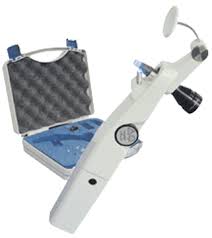Measuring corneal thickness is important because it can conceal an accurate reading of the intraocular (eye) pressure. The intraocular pressure (IOP) is important in determining your risk for glaucoma. This pressure and glaucoma development has been discovered to be linked with corneal thickness if not measured accurately. Careful control of eye pressure with medications can help prevent vision loss.
Corneal pachymetry is a test used to measure the thickness of the cornea. This test is simple, quick and painless to measure. The procedure only takes about one minute to measure the pressure in both eyes. To test for this, a licensed optometrist will first numb the eye with anesthetic drops. They will then use a device called a tonometer pen (see below). This tonometer pen is used by tapping the cornea of the eye, one time lightly. It will then quickly calculate the cornea thickness on a digital display. Because the IOP and corneal thickness have direct correlation with each other, an IOP measurement will have to be taken after the thickness measurement is acquired. With this measurement, the optometrist can better understand what the IOP is indicating in the eye. IOP readings are taken using a different method. After the measurement of the cornea thickness is taken, a treatment plan can be put into place, if needed. An acceptable level of thickness of the cornea is roughly 540 microns (half of one millimeter).
DIFFERENCES IN CORNEAL THICKNESS

Thin Cornea
Often times, patients with thinner corneas show significantly low IOP readings. This is potentially dangerous because if the true IOP reading is actually higher, the patient can be at risk for developing glaucoma or vision loss and the optometrist would not be aware of it. It’s imperative to have an accurate reading to determine the risk and treat accordingly.
Thick Cornea
Patients with a thicker cornea may indicate higher IOP readings than are actually there. This would mean the eye pressure is lower than the optometrist may think. This false reading of a higher IOP would mean that eye drops are given to lower the eye pressure when they aren’t necessary. Conversely, it is important to have regular eye exams to monitor this pressure in the event that it changes.
Comprehensive Mobile’s vision plan includes measuring the corneal thickness yearly to ensure the thickness is evaluated appropriately. In addition, Comprehensive Mobile’s vision plan also includes measuring the IOP of the eye twice yearly to confirm the pressure in the eyes is showing an acceptable level as well. The thickness and pressure levels work in tandem with each other. Because of this, regular eye exams measuring corneal thickness is imperative to minimize the risk of vision loss.
SOURCES FOR THIS MATERIAL: Glaucoma Research Foundation; Perkins Tonometer
